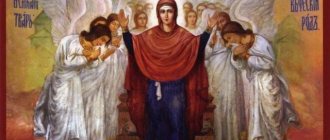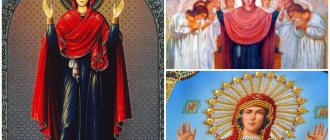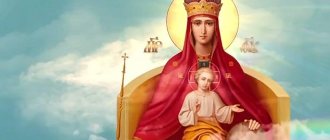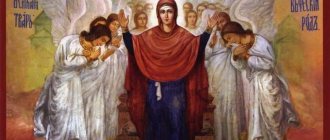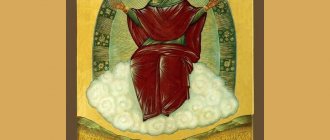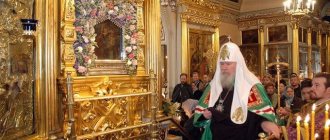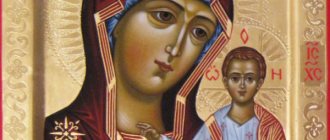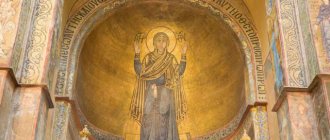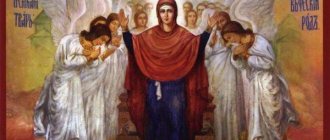What can you ask for before the image?
Every Orthodox believer must figure out in advance what they can ask the holy image for.
Helps with travel
Often prayer texts are said to the Mother of God before leaving their home for a long time. Therefore, people who are going to go on a work trip or a long trip should first pray to the Unbreakable Wall icon. In this case, the first prayer service is read on the day of departure. In the process of saying prayer, you must ask the Mother of God to protect the abandoned housing. You can also pray while traveling.
After returning home, you should thank the Mother of God for her help.
About protecting home and family
If a loved one suffers grief or illness
Close people often face illnesses and other unpleasant grief throughout their lives. To protect loved ones from misfortune, it is recommended to regularly pray to the face of the Holy Mother of God. The prayer service must be read while standing in front of the image of the Holy Mother of God. At the same time, one must pray sincerely, with faith in the spoken words. If the prayer text is pronounced without faith, the prayer will not work and will not help in any way.
In case of family disagreements
In young married couples, disagreements often arise, due to which the relationship between people begins to deteriorate. To cope with emerging problems, people often visit specialists. However, they do not always help and therefore you have to turn to faith. Prayer to the icon of the Unbreakable Wall can restore the family and eliminate all differences that have arisen. However, the married couple will have to read the prayer service together. At the same time, they both must sincerely want to restore the family.
Soon to get married
Many young girls dream of finding a good guy to marry him in the future. However, some have difficulty finding a husband. Girls who cannot cope with this problem on their own turn to the face of the Mother of God for help. A correctly read prayer in front of the icon will help in finding a young man whom you can marry in the future.
Family happiness
Family happiness is what not only young girls, but also boys dream about. However, not all people manage to live a happy family life, so they have to achieve happiness in different ways. One of the methods for achieving family happiness is turning to the Mother of God. Before praying to her, they place an icon with the image of the saint in front of them. Prayer words addressed to the image are considered more effective.
Conception and pregnancy
Most married couples sooner or later decide to have a baby. However, problems may arise, since not all girls manage to get pregnant. People who have encountered problems with conception should periodically turn to the face of the Mother of God. Reading a prayer can speed up the process of conception significantly.
Examples of miracles
The Icon of the Unbreakable Wall is known for its ability to perform miracles if you pray to it periodically. For example, the most famous miracles are associated with the holy list, which was created for the Resurrection-Myrrh Monastery. In the temple, where the image of the Mother of God has been kept for the last 50 years, several miracles have occurred during this time. With her help, spouses and relatives were repeatedly reconciled. Also, prayer to the saint’s face helped to find a person who was considered missing for more than ten years.
Lyrics
Before you start praying, you need to familiarize yourself with the texts of the prayers.
Troparion
“We now diligently approach the Mother of God, sinners and humility, and let us fall, calling in repentance from the depths of our souls: Lady, help us, having had mercy on us, struggling, we are perishing from many sins, do not turn away your slaves, for you are the only hope of the imams.
Like an indestructible wall and an omnipotent cover of the treasures of Thee, Thy servants, the Lady Theotokos, driving away the darkness of sins and sorrows. We also cry out to You: grant world peace and light and salvation to our souls.”
Kontakion
“Chosen from all generations to the Mother of God and the Queen, before Her most pure image, the Indestructible Wall called, we offer thanksgiving praise to You, O Blessed One. But you, who have incomprehensible power and unspeakable love, save us from all troubles and sorrows, and let us call to You: Rejoice, Mother of God, Indestructible Wall, our Intercessor and consolation.”
Greatness
“We magnify You, Most Holy Virgin, God-chosen Youth, and honor Your holy image, through which you bring healing to all who come with faith.”
Prayer
“Oh, our gracious Lady Theotokos, Ever-Virgin, accept from us this song of gratitude and offer up to our Creator and Creator your warm prayers for us unworthy, may He, the Merciful, forgive us all our sins, evil and unclean thoughts, nasty deeds. Oh, Most Holy Lady, have mercy and send down a gift according to each need: heal the sick, comfort the sorrowing, bring the lost to reason, protect the infants, raise and teach the young, encourage and instruct men and wives, support and warm the old, be with us both here and in life eternal Wall, Indestructible, deliver us from all troubles and misfortunes and from eternal torment, and always singing Your Motherly love, we praise with all our hearts Your Son, with His Father and the Holy Spirit, forever and ever. Amen".
Akathist
“A representative angel was sent quickly from God to You, Most Pure One, to bring You worldwide joy, as You conceived God the Word, the Savior of the world, from the Holy Spirit in Your womb. We, leading the fulfillment of this annunciation, believe that the Lord, Most Blessed One, has shown You as an Indestructible Wall and a barrier for us from all sin, troubles and misfortunes. For this sake, let us please Thee, Mother of God, and joyfully cry out:
Rejoice, for the Lord is with You and You with us.
Rejoice, for in Cana of Galilee you appeared as a representative to Your Son for the people.
Rejoice, for with Your omophorion, who broadens the clouds, you cover the faithful.
Rejoice, for with Your grace you wipe away the tears of the suffering.
Rejoice, for You lift up Your hands to protect us from all defilement.
Rejoice, for according to Your word you are now and ever blessed.
Rejoice, Mother of God, Indestructible Wall, our Intercessor and consolation.”
Reading rules
According to the church charter, the hymn of praise can only be read while standing. The exception is people who do not have the physical ability to walk or stand. Also, according to the charter, during Lent it is forbidden to read any akathist, except for the Mother of God of Constantinople and dedicated to the Passion of Christ. On other days, a prayer service can be held on any day and time of day.
In the morning and evening, if the rule is read before the prayer service, the song begins before the words “It is worthy to eat...”. The rest of the time, the chant should be preceded by prayer speeches: “Psalm 50” and “Creed.”
General information and meaning
In the Orthodox Church there are several thousand iconographic images of the Virgin Mary, each of which carries a certain meaning and significance in the life of Christian believers. According to the clergy, the images of “Tenderness”, “Inexhaustible Chalice” and “Indestructible Wall” are very popular among the laity.
Praying to the Mother of God in front of the “Unbreakable Wall” shrine, Orthodox Christians read a “folk prayer” called an akathist. An akathist is an ode of gratitude, a song of praise in the name of God, the Mother of God, saints and archangels.
The Akathist consists of 25 songs (13 kontakia and 12 ikos), distinguished by their light syllables and deep meaning. You can read the ode of gratitude in church during a service or at home, in solitude and away from worldly affairs and vanity.
Akathist to the Most Holy Theotokos “The Unbreakable Wall” read:
The “Unbreakable Wall” icon got its name due to its own “indestructibility”. The image of the Mother of God, which was located for many centuries in the church at the Kiev monastery, survived countless natural disasters, wars and battles. Over many years of battles and confrontations, Kyiv was devastated and plundered, the Kiev monastery (Hagia Sophia in Kyiv) was completely destroyed and plundered, but the shrine “The Unbreakable Wall” remained intact. The face of the Virgin Mary was not affected by fires or natural disasters - the icon remained safe and sound.
This event, which Christian believers call a real miracle, attracted the attention of the laity to the shrine. The icon depicting the Most Holy Theotokos “The Unbreakable Wall” has become one of the widely revered icons among Orthodox Christians.
From ancient times to the present day, the main monastery of the image of the Mother of God “The Unbreakable Wall” is the Hagia Sophia Cathedral in Kyiv. The shrine is installed at the main altar of the temple above a mountainous place.
Another icon depicting the Mother of God “The Unbreakable Wall”, which was painted in the image of the shrine at the St. Sophia Cathedral in Kyiv and the monastery in Constantinople (now Istanbul, Turkey), is located at the Resurrection-Myrrh-Bearing Monastery in the village of Nikolskoye. As church ministers say, this icon was consecrated by the holy saint John of Kronstadt, whose pastoral life fell on troubled times. During the period of atheism and devastation, the Resurrection-Myronositsky Monastery was attacked and robbed by non-believers, but the icon of the Mother of God “The Unbreakable Wall” was saved by one of the local parishioners.
The Shrine of Our Lady is endowed with special power. Throughout the world, the image of the Mother of God has brought many incredible phenomena and miraculous acts, inexplicable miracles and healings. You can get acquainted with the lists of the miraculous deeds of the shrine in the Church of the Nativity of the Blessed Virgin Mary, in the Church of the Apostles Peter and Paul in Moscow, in the convent of the Icon of the Mother of God “Vsetsaritsa” in the Krasnodar Territory, in the chapel of the Cathedral of Kaliningrad and in the Essentuki Church of the Assumption of the Blessed Virgin Mary in the Stavropol Territory.
The history of the appearance of the akathist
The image of the Virgin Mary, known as the “Unbreakable Wall,” has adorned the St. Sophia Cathedral in Kyiv for 9 centuries. The peculiarity of the icon, made in the “Oranta” style, is that it is a large mosaic panel. The golden background, the golden stone on which the Mother of God stands, the golden omophorion (cloak), the stars on her face and shoulders create a solemn mood in the perception of the image.
The origin of the name is explained by two points:
- Quote from the akathist to the Heavenly Lady (kontakion 12): “Rejoice, indestructible wall of the kingdom...”.
- The preservation of the cathedral wall with the icon for many centuries, while Kyiv and St. Sophia Cathedral were repeatedly destroyed.
According to legend, the mosaic panel is a talisman of Kyiv: as long as the icon exists, the city is not in danger of destruction. The icon is revered as miraculous; an akathist was compiled in its honor in the second half of the 18th century, and the day of celebration was set as May 31 (June 14).
In Russian Orthodoxy, hymnography was borrowed from the Greek Orthodox Church. In memory of the miracle that occurred through prayers before the image of the Mother of God during the siege of Constantinople in the 6th century, the first akathist (hymn of praise) was composed.
Beginning in the 11th century, the Constantinople hymn was included in the services of the Russian Orthodox churches. The rapid development of the genre began in the 18th century.
Since that time, the rule for compiling akathists has been established in the Russian Orthodox tradition:
- to the miraculous images of the Mother of God;
- Jesus Christ;
- significant events of the New Testament;
- revered saints.
Any believer could become a writer, regardless of status: spiritual, military, civilian. But for church-wide approval, the text of the hymn must be submitted for examination to the review committee of the Holy Synod of the Russian Orthodox Church. According to his conclusion, the work is recommended for church-wide or only for private reading.
